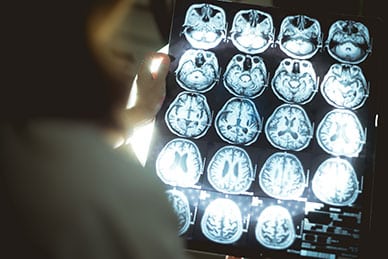Recent research has brought to light a few key factors that can significantly contribute to your risk of dementia. Here, we highlight some of the newest findings regarding dementia and cognitive decline.
A Healthy Brain Starts With a Healthy Heart: How Improving Your Heart Health Could Lower Your Risk of Dementia
In a new study published in the Journal of the American Medical Association, a team of researchers demonstrated that steps taken to improve heart health have the added benefit of lowering one’s risk of experiencing dementia or cognitive decline in late life. Using the seven heart health metrics defined by the American Heart Association, the team assessed a combination of modifiable health behaviors and biological components and their link to cognitive decline. According to the team’s findings, each individual parameter reduces the risk of developing dementia by 10 percent, for a total risk reduction of 70 percent if all metrics are kept in check.
Seven Steps to Improve Cardiovascular Health and Lower Dementia Risk
- Eat a healthful diet.
- Stay physically active.
- Maintain a healthy weight and BMI.
- Keep cholesterol levels under control.
- Maintain a healthy blood pressure.
- Reduce blood sugar levels.
- Don’t smoke cigarettes.
While the authors admit the limitations of the study, it nevertheless demonstrates that steps taken to better heart health are strongly associated with a decreased risk of dementia and cognitive decline, and that addressing even one area positively impacts the risk of cognitive decline. INSERM’s Cécilia Samieri commented, “In practice, this objective appears more realistic, making it possible to reach a larger number of people and therefore have a greater impact. While health promotion is a collective challenge for public authorities and healthcare professionals, it also involves each individual taking ownership of their own health.”
Belly Fat Linked to Cognitive Decline: How Your Waist-to-Hip Ratio Impacts Your Brain
Bearing a direct impact on cholesterol, blood pressure and blood sugar levels, a person’s body mass index (BMI) affects nearly all facets of cardiovascular health. In fact, obesity is one of the top risk factors for cardiovascular disease and, according to researchers from Trinity College in Dublin, cognitive decline as well. The study, which was published in the British Journal of Nutrition, examined the health data over more than five thousand Irish adults over the age of 60 and found that higher waist-to-hip ratios were associated with a decline in cognitive abilities.
 With the number of obese people on the rise around the globe and the prevalence of dementia expected to increase to upwards of 80 million by the year 2040, these findings could have “significant implications” for many. Senior study author Conal Cunningham, an associate professor at Trinity College said in a press release, “While we have known for some time that obesity is associated with negative health consequences our study adds to emerging evidence suggesting that obesity and where we deposit our excess weight could influence our brain health. This has significant public health implications.”
With the number of obese people on the rise around the globe and the prevalence of dementia expected to increase to upwards of 80 million by the year 2040, these findings could have “significant implications” for many. Senior study author Conal Cunningham, an associate professor at Trinity College said in a press release, “While we have known for some time that obesity is associated with negative health consequences our study adds to emerging evidence suggesting that obesity and where we deposit our excess weight could influence our brain health. This has significant public health implications.”
How Pregnancy, Reproductive History, and Hormone Therapy Impact Cognitive Decline
New findings shared at this year’s Alzheimer’s Association International Conference (AAIC) drew attention to sex differences among dementia and Alzheimer’s patients over the lifespan. “More women than men have Alzheimer’s disease or other dementias; almost two-thirds of Americans with Alzheimer’s are women,” said Dr. Maria Carrillo, the Alzheimer’s Association’s Chief Science Officer. According to the 2018 Facts and Figures Report published by the Alzheimer’s Association, 3.4 million out of 5.5 million elderly Americans diagnosed with Alzheimer’s disease are women. Here are a few of the top findings on women’s health presented at this year’s conference.
A Woman’s Reproductive History is Linked to Dementia Risk
Researchers from Northern California investigating different facets of reproduction with regards to incurred dementia risk uncovered associations between the risk of dementia and numerous reproductive factors. “Possible causes of dementia in women, in particular reproductive factors, are not well understood,” explained Dr. Paola Gilsanz, a staff scientist at Kaiser Permanente’s Northern California Division of Research. “In our study, we aimed to identify female-specific risks and protective factors impacting brain health, which is critical to diminishing the disproportionate burden of dementia experienced by women.”
According to their findings:
- Women who have had three or more children are 12 percent less likely to develop dementia when compared with women who have had only one child.
- Each incidence of miscarriage increases the risk of dementia by 9 percent when compared to women who have had no miscarriages.
- Women who started their first period at the age of 16 or older are 31 percent more at risk of dementia than those who have their first period at the average age of 13.
- Women who experience the onset of natural menopause at the age of 45 or younger have a 28 percent greater risk of developing dementia when compared to women who naturally enter menopause after 45.
- The length of a woman’s reproductive period averaged around 34 years. Women whose reproductive periods span 21 to 30 years in length are 33 percent more at risk of dementia when compared to women whose reproductive periods span between 38 to 44 years.
Pregnancy History Affects the Risk of Alzheimer’s Disease in Women
In order to investigate possible associations between Alzheimer’s risk and a woman’s reproductive history, researchers from the University of California at Los Angeles collected pregnancy histories and measures of dementia symptoms and found that the cumulative months of pregnancy could serve as a “significant predictor” for the risk of Alzheimer’s disease. According to their data, women who spend 12.5 percent more months pregnant than an otherwise identical woman are 20 percent less likely to develop Alzheimer’s. The researchers believe that the body’s immune response during the first trimester of pregnancy may be the mechanism underlying the reduced risk.
“We are intrigued by the possibility that pregnancy may reorganize the mother’s body in ways that could protect her against developing Alzheimer’s later in life. These results also suggest that the story might not be so simple as being all about estrogen exposure, as previous researchers have suggested,” said Dr. Molly Fox, an assistant professor at UC Los Angeles.
Hormone Therapy is Not Always Linked to Cognitive Decline
Researchers reviewing recent studies regarding cognition and hormone therapy found that only under certain circumstances was hormone therapy associated with cognitive impairment. In particular:
- Women who begin hormone therapy between the ages of 50 and 54 encountered no negative cognitive effects.
- Women who start hormone therapy between the ages of 65 and 79, however, saw decreased cognition, impaired memory and reduced higher functioning.
- Women with type 2 diabetes undergoing hormone therapy were found to have a higher risk of cognitive decline than either diabetic women not on hormone therapy or non-diabetic women who were on hormones.
Dr. Carey Gleason of the Wisconsin Alzheimer’s Disease Research Center commented, “These findings add to our understanding of the complex effects of hormones on the brain. These data are sorely needed to guide women’s healthcare during and after the menopausal transition and to help women make personalized and informed decisions regarding management of their menopausal symptoms and the prevention of future adverse health outcomes.”
A Woman’s Verbal Memory Advantage Could Mask the Earliest Stages of Alzheimer’s
Data suggests that, throughout the aging process, women possess an advantage when it comes to remembering words and verbal materials. Many of the current tests used for diagnosing Alzheimer’s rely on verbal memory and word recall, story recollection and other verbal items. Researchers hoping to form a better understanding of these sex differences in verbal memory in the aging brain found that, even though their brains presented moderate signs of Alzheimer’s degradation, women indeed maintained higher levels of cognitive performance in the earlier stages of the disease when compared to men, though the advantage diminished as the disease progressed.
“These findings may help to explain why women show a more rapid decline across a wide range of cognitive abilities after being diagnosed with Alzheimer’s. While the female advantage may be functionally beneficial, it could mask early stages of Alzheimer’s, resulting in a more severe burden of disease at the time of diagnosis, with more rapid deterioration thereafter,” said Dr. Pauline Maki, Senior Research Director at the University of Illinois’s Center for Research on Women and Gender.
The use of diagnostic tests based upon gender improved the accuracy of diagnosis in both men and women, which suggests a need for further research into alternative diagnostic approaches.
Painkillers Used to Treat Chronic Pain in Dementia Patients Can Triple Harmful Side Effects
Also presented at this year’s AAIC were a pair of studies highlighting the effects of opioid painkillers in people living with dementia and the potential mechanisms underlying these effects.
Approximately half of dementia patients in care facilities live with “clinically significant pain,” which is often mismanaged or even undiagnosed. Researchers found that the opioid-based painkillers commonly used to treat pain increased the negative side effects — like confusion, lethargy, and mood swings — by threefold in dementia patients.
“Pain is a symptom that can cause huge distress and it’s important that we can provide relief to people with dementia. Sadly, at the moment, we’re harming people when we’re trying to ease their pain. We urgently need more research in this area, and we must get this dosing right. We need to establish the best treatment pathway and examine appropriate dosing for people with dementia,” commented the University of Exeter’s Professor of Age-Related Diseases, Clive Ballard.
While opioid painkillers are an effective treatment, dementia patients require smaller doses for pain relief and seem to more sensitive to negative side effects of the drugs. Research suggests that this may be because dementia patients’ bodies appear to overproduce its natural endogenous opioids.
 A long-term deficiency carries a significant risk of permanent brain and nerve damage. B12 deficiency has been known to put some people at a higher risk of mental health issues such as dementia, mania or psychosis. A B12 deficiency also impacts immune response and can increase susceptibility to infection or disease. Long-term deficiency leads to the onset of anemia, which may be accompanied by any number of symptoms:
A long-term deficiency carries a significant risk of permanent brain and nerve damage. B12 deficiency has been known to put some people at a higher risk of mental health issues such as dementia, mania or psychosis. A B12 deficiency also impacts immune response and can increase susceptibility to infection or disease. Long-term deficiency leads to the onset of anemia, which may be accompanied by any number of symptoms: The team analyzed the participants’ brain imaging data along with their food choices and found that the grey matter volume in the dorsolateral prefrontal cortex (dlPFC) and ventromedial prefrontal cortex (vmPFC) could predict each participant’s ability to focus on health and not think about taste when told to do so. Those with denser grey matter volume in these two regions displayed more
The team analyzed the participants’ brain imaging data along with their food choices and found that the grey matter volume in the dorsolateral prefrontal cortex (dlPFC) and ventromedial prefrontal cortex (vmPFC) could predict each participant’s ability to focus on health and not think about taste when told to do so. Those with denser grey matter volume in these two regions displayed more  In order to gain a better understanding of serotonin’s function within the hippocampus and how it relates to memory and learning, the team used a technique called optogenetics. Optogenetics makes use of pulses of light to either stimulate or inhibit neuronal activity. The researchers used this technique to essentially turn the receptors on and off in order to study the various serotonin pathways in the hippocampal CA1 region.
In order to gain a better understanding of serotonin’s function within the hippocampus and how it relates to memory and learning, the team used a technique called optogenetics. Optogenetics makes use of pulses of light to either stimulate or inhibit neuronal activity. The researchers used this technique to essentially turn the receptors on and off in order to study the various serotonin pathways in the hippocampal CA1 region. After reaching middle age, most adults will begin to lose an average of three percent of their muscle mass, strength and endurance each year. This age-related decline in muscular function referred to as
After reaching middle age, most adults will begin to lose an average of three percent of their muscle mass, strength and endurance each year. This age-related decline in muscular function referred to as  Dr. Valdez concludes that for researchers, “the next step is to identify the mechanism that enables resveratrol to protect synapses. If we know the mechanism, we can modify resveratrol or look for other molecules that are more effective at protecting the synapses.”
Dr. Valdez concludes that for researchers, “the next step is to identify the mechanism that enables resveratrol to protect synapses. If we know the mechanism, we can modify resveratrol or look for other molecules that are more effective at protecting the synapses.”